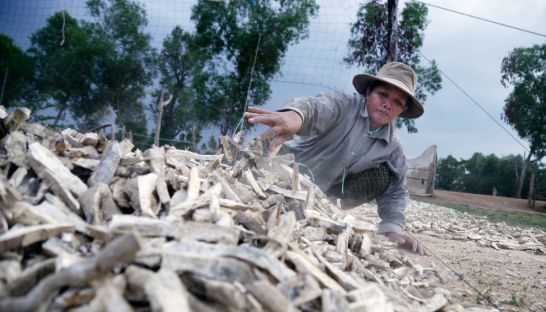Cassava industry left out to dry
Cassava industry left out to dry
With the start of the dry harvest season for cassava kicking off, farmers are calling for the government to support the struggling sector with initiatives to address recurring capital shortages and market volatility.

Sum Heang, head of the Pailin Cassava Association, which represents 52 cassava-growing families in Pailin province, said yesterday the unglamorous root crop has always taken a distant second place to rice on the government’s agenda.
“The cassava industry is struggling and is in a worse predicament than rice, yet we never get the same level of attention from the government as the rice sector, which has received state support in the form of emergency loans and marketing,” Heang said.
Cassava is Cambodia’s largest agricultural export crop by tonnage, and believed to be the second-biggest by value after rice. The cash crop, which has never been a staple of the Cambodian diet, is cultivated on nearly 600,000 hectares, yielding about 13 million tonnes a year for export.
Official export data provided by the Ministry of Agriculture show about 2.3 million tonnes of sliced cassava, 570,000 tonnes of fresh cassava and a small volume of cassava starch, were exported in 2015, mostly to Thailand, Vietnam and China. Most of the remaining 10 million tonnes were believed to have been smuggled across the country’s borders.
Heang said a dearth of local processing capacity has forced a dependence on neighbouring markets, with desperate farmers routinely selling their fresh or sliced cassava to foreign brokers, who make large profits in processing the root. Prices are set abroad, and farmers are extremely vulnerable to market volatility and frequent border closures.
“Nobody cares about the cassava sector,” Heang declared. “We never get any financial support from the government, and it never intervenes when our crop shipments are blocked at the border.”
She added that many farmers had given up on cassava and emigrated to other countries in search of work to pay off their debts. Those left in the sector, mostly impoverished elderly farmers, are seeking government support, such as credit facilities or price floors during the harvest season.
Mey Kalyan, senior adviser for the Supreme National Economic Council (SNEC), said all of Cambodia’s agricultural sectors were facing issues, and the government had limited resources to address all of them.
This meant the private sector would have to take the lead, starting first off by ending the individualism and haphazard practices that were driving down market prices.
Kalyan suggested that the cassava sector’s stakeholders band together to form an industry body, similar to the Cambodian Rice Federation (CRF).
“Producers and exporters should unify under strong leadership and work together to address the issues and lobby the government to take action,” he said. “Prices would not fluctuate if we could ensure quality control and build up buyer confidence, and this would resolve many issues.”
Lor Reaksmey, a spokesman for the Ministry of Agriculture, dismissed the idea of an industry body for cassava producers, claiming it was unnecessary. He said the government recognises the importance of cassava and was seeking new markets for the crop as well as solutions to the issues that farmers face.
“Cassava producers do not have a federation like that of the rice sector, but we [the government] are solving issues for the farmers and inter-ministerial bodies are seeking markets for them,” he said.
Reaksmey said that the government was currently negotiating with its Thai counterpart to arrange a quota for cassava exports. It is also looking closely at the contract farming model.
“We will try to help the cassava sector by encouraging contract farming, and this will guarantee the market price,” he said.













